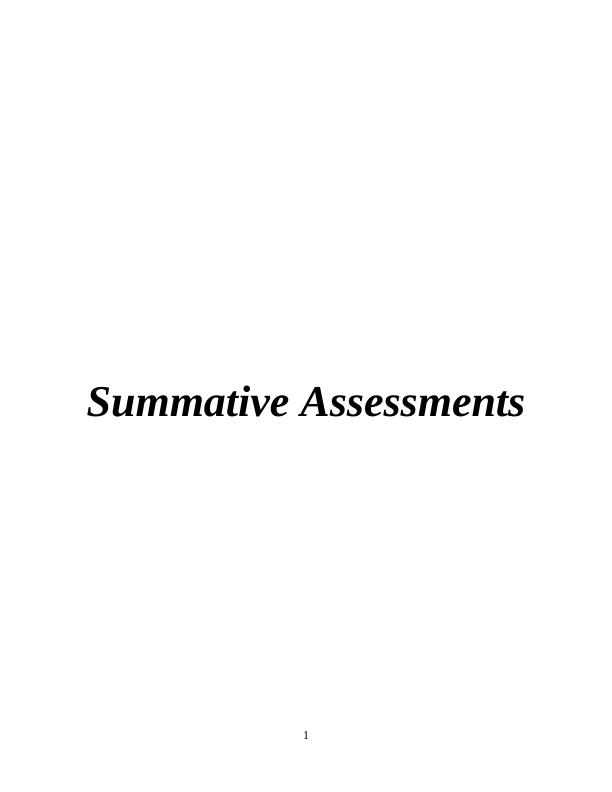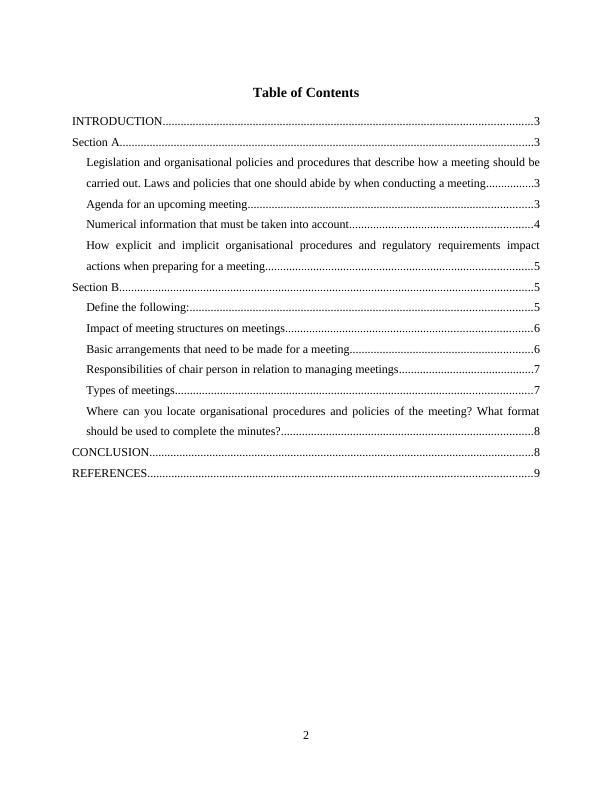Legislation and Organisational Policies for Conducting Meetings
Added on 2023-01-09
9 Pages2835 Words80 Views
Summative Assessments
1
1

Table of Contents
INTRODUCTION...........................................................................................................................3
Section A..........................................................................................................................................3
Legislation and organisational policies and procedures that describe how a meeting should be
carried out. Laws and policies that one should abide by when conducting a meeting................3
Agenda for an upcoming meeting...............................................................................................3
Numerical information that must be taken into account.............................................................4
How explicit and implicit organisational procedures and regulatory requirements impact
actions when preparing for a meeting.........................................................................................5
Section B..........................................................................................................................................5
Define the following:..................................................................................................................5
Impact of meeting structures on meetings..................................................................................6
Basic arrangements that need to be made for a meeting.............................................................6
Responsibilities of chair person in relation to managing meetings.............................................7
Types of meetings.......................................................................................................................7
Where can you locate organisational procedures and policies of the meeting? What format
should be used to complete the minutes?....................................................................................8
CONCLUSION................................................................................................................................8
REFERENCES................................................................................................................................9
2
INTRODUCTION...........................................................................................................................3
Section A..........................................................................................................................................3
Legislation and organisational policies and procedures that describe how a meeting should be
carried out. Laws and policies that one should abide by when conducting a meeting................3
Agenda for an upcoming meeting...............................................................................................3
Numerical information that must be taken into account.............................................................4
How explicit and implicit organisational procedures and regulatory requirements impact
actions when preparing for a meeting.........................................................................................5
Section B..........................................................................................................................................5
Define the following:..................................................................................................................5
Impact of meeting structures on meetings..................................................................................6
Basic arrangements that need to be made for a meeting.............................................................6
Responsibilities of chair person in relation to managing meetings.............................................7
Types of meetings.......................................................................................................................7
Where can you locate organisational procedures and policies of the meeting? What format
should be used to complete the minutes?....................................................................................8
CONCLUSION................................................................................................................................8
REFERENCES................................................................................................................................9
2

INTRODUCTION
In order to be successful at work, a person is required to have certain skills, knowledge as
well as experience. This not only helps them in performing better, but also in keeping them
informed about the latest trends in the industry. This report is divided into three sections and
each section addresses a set of questions (Beigel and et. al., 2019). The report discusses the
legislation as well as organisational policies that explain how meetings should be conducted. It
also includes an agenda for a meeting which includes the purpose of meeting, intended
participants and different supporting texts that need to be read. It also includes an explanation of
how meeting structures can impact meetings. Apart from this, the basic arrangements that need
to be made for a meeting are also included in the report.
Section A
Legislation and organisational policies and procedures that describe how a meeting should be
carried out. Laws and policies that one should abide by when conducting a meeting
There are different organisation policies and procedures that describe how a meeting
should be carried out successfully. For a meeting to be successful, it is important to select a place
wherein there is no noise or any kind of disturbance. As per legislation policies, in order to carry
out a meeting, the different procedures include minutes, agenda, voting, divisions, tabling of the
important information, petitions etc. It is important to follow all these procedures as they can
help in carrying out the meeting effectively. It is important to abide by certain laws and policies
when conducting a meeting. For example, the purpose of the meeting should be specified, there
should be an agenda for the meeting and it should be made sure that there is open and clear
communication among the participants. Also, before speaking their point, permission from the
chairman should be taken (Cahill and et. al., 2017). Also, when the chairman is about to speak,
no other person should speak. The points being made by a person should be brief and
understandable.
Agenda for an upcoming meeting
A meeting agenda can be described as a list of items that all of the participants of the
meeting intend to accomplish. The agenda is usually distributed before the meeting is conducted
so that the participants can prepare themselves for the meeting. A meeting can be defined as a
gathering wherein people come together to discuss a topic and exchange information. In context
3
In order to be successful at work, a person is required to have certain skills, knowledge as
well as experience. This not only helps them in performing better, but also in keeping them
informed about the latest trends in the industry. This report is divided into three sections and
each section addresses a set of questions (Beigel and et. al., 2019). The report discusses the
legislation as well as organisational policies that explain how meetings should be conducted. It
also includes an agenda for a meeting which includes the purpose of meeting, intended
participants and different supporting texts that need to be read. It also includes an explanation of
how meeting structures can impact meetings. Apart from this, the basic arrangements that need
to be made for a meeting are also included in the report.
Section A
Legislation and organisational policies and procedures that describe how a meeting should be
carried out. Laws and policies that one should abide by when conducting a meeting
There are different organisation policies and procedures that describe how a meeting
should be carried out successfully. For a meeting to be successful, it is important to select a place
wherein there is no noise or any kind of disturbance. As per legislation policies, in order to carry
out a meeting, the different procedures include minutes, agenda, voting, divisions, tabling of the
important information, petitions etc. It is important to follow all these procedures as they can
help in carrying out the meeting effectively. It is important to abide by certain laws and policies
when conducting a meeting. For example, the purpose of the meeting should be specified, there
should be an agenda for the meeting and it should be made sure that there is open and clear
communication among the participants. Also, before speaking their point, permission from the
chairman should be taken (Cahill and et. al., 2017). Also, when the chairman is about to speak,
no other person should speak. The points being made by a person should be brief and
understandable.
Agenda for an upcoming meeting
A meeting agenda can be described as a list of items that all of the participants of the
meeting intend to accomplish. The agenda is usually distributed before the meeting is conducted
so that the participants can prepare themselves for the meeting. A meeting can be defined as a
gathering wherein people come together to discuss a topic and exchange information. In context
3

End of preview
Want to access all the pages? Upload your documents or become a member.
Related Documents
Managing Meetings: Procedures, Policies, and Best Practiceslg...
|10
|2456
|356
Manage Meetings: Assignmentlg...
|17
|4269
|237
BSBADM502 Manage Meetingslg...
|20
|5779
|2
BSBADM502 Manage meetingslg...
|56
|10242
|218
BSBADM502 Manage Meetings - Agenda, Legislation, Presentation, Notification, Correspondence, Requirements, Role Play, Follow Uplg...
|11
|2912
|292
Communicate with Influence: Essential Elements of Meeting, Roles and Responsibilities of Chairperson, Minutes Distribution and Storagelg...
|8
|1968
|126
